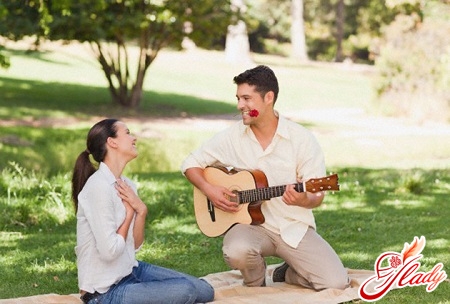 Ah, love, love... They dedicate poems to you, ohThey sing to you, they dream about you and admire you, they wait for you, they hate you and fear you. Yes, yes, they fear you, because everything that has no explanation usually scares. This is probably why humanity has been trying to find a clue to the phenomenon of this feeling that can create, destroy, drive you crazy and lift you to the skies since ancient times. And it struggles to find an answer, unsuccessfully trying to find a clear explanation for the emergence of passionate love between two people. It struggles stubbornly, sometimes exclaiming: "Eureka!" (does everyone remember the venerable Count Cagliostro?), and then sighing in disappointment - again, not it. Why do people love each other? We are probably not given the answer to this question. The secret of magic that arises between representatives of both sexes has existed since time immemorial and until now it has not been revealed by any mortal. And why? After all, the pragmatic world, devoid of any illusions, bustling, mired in intrigue and lies, suddenly for a brief moment seems to remove the hateful mask and appear before a person in a completely different form. It enchants with the charm of blooming gardens, enchants with the singing of a nightingale on a May night, amazes the imagination with the beauty of landscapes... It reveals all this only to those who have experienced love at least once in their life. So why look for an explanation for such magic? It is much more correct to simply believe in it and, like an enthusiastic child, wait for fate to give you this greatest gift, the opportunity to touch an ancient secret and become, at least for a moment, a part of world harmony and universal happiness. Of course, fate gives this chance to all people. But each person experiences love in their own way. It torments someone, for someone it transforms into hatred, brings joy to someone, and inspires someone to great achievements. Modern psychologists, studying this phenomenal feeling, tried to classify it (oh, these realists!) and identified the main types of love. Let's see what definitions they gave to the magic that illuminates and fills our lives with meaning.
Ah, love, love... They dedicate poems to you, ohThey sing to you, they dream about you and admire you, they wait for you, they hate you and fear you. Yes, yes, they fear you, because everything that has no explanation usually scares. This is probably why humanity has been trying to find a clue to the phenomenon of this feeling that can create, destroy, drive you crazy and lift you to the skies since ancient times. And it struggles to find an answer, unsuccessfully trying to find a clear explanation for the emergence of passionate love between two people. It struggles stubbornly, sometimes exclaiming: "Eureka!" (does everyone remember the venerable Count Cagliostro?), and then sighing in disappointment - again, not it. Why do people love each other? We are probably not given the answer to this question. The secret of magic that arises between representatives of both sexes has existed since time immemorial and until now it has not been revealed by any mortal. And why? After all, the pragmatic world, devoid of any illusions, bustling, mired in intrigue and lies, suddenly for a brief moment seems to remove the hateful mask and appear before a person in a completely different form. It enchants with the charm of blooming gardens, enchants with the singing of a nightingale on a May night, amazes the imagination with the beauty of landscapes... It reveals all this only to those who have experienced love at least once in their life. So why look for an explanation for such magic? It is much more correct to simply believe in it and, like an enthusiastic child, wait for fate to give you this greatest gift, the opportunity to touch an ancient secret and become, at least for a moment, a part of world harmony and universal happiness. Of course, fate gives this chance to all people. But each person experiences love in their own way. It torments someone, for someone it transforms into hatred, brings joy to someone, and inspires someone to great achievements. Modern psychologists, studying this phenomenal feeling, tried to classify it (oh, these realists!) and identified the main types of love. Let's see what definitions they gave to the magic that illuminates and fills our lives with meaning.
Love-sickness is not deadly
According to American psychologist DorothyAccording to Tennov, the author of the book "Love and Infatuation", what we often take for such a deep and tender feeling is nothing more than the action of a blind mechanism of nature, the main purpose of which is the reproduction of individuals and the upbringing of their common children for some time. This is very reminiscent of the relationships between people of cave times, when relationships were formed solely for the continuation of the family line, there was a short period after the child was born so that he could get a little stronger, and they fell apart as soon as all the other members of the clan could take care of the baby, easing the mother's responsibilities. The father, however, found a new woman and acquired another offspring. This feature of the existence of our ancient ancestors, due to the need to continue the family line at any cost, often manifests itself even now. After all, young marriages have an unpleasant tendency to fall apart three or four years after registration and the birth of the first child. Here you have the genetic memory of generations! According to Tennov, such fleeting feelings should be called painful infatuation, which has symptoms such as:
- obsessive thoughts about the object of passion;
- pathologically painful requirement of reciprocal feelings;
- a sense of euphoria, if the feeling is reciprocated.
In this case, the object of love becomesa person so significant that it completely overshadows the consciousness and pushes into the background the performance of important duties and the solution of pressing problems. It is perceived somewhat distorted: its positive qualities are exaggerated, and the negative ones are either not noticed or seen as virtues. A person in love experiences a constant attraction to the object of his strongest affection, mixed with sexual desire. This is not a trivial desire to simply passionately surrender to carnal pleasures, which passes immediately after intimacy. Love-sickness implies an enduring sexual craving that is impossible to satisfy. There is no effective cure for this ailment. If the feelings are not mutual and bring only suffering, in order to heal from them, Tennov advises to completely stop contact with the object of adoration or switch attention to another person. Both of these things are, of course, quite difficult to do, but this guarantees recovery without any special psychological complications. In general, love-sickness is not fatal and usually goes away on its own within two to four years, even if it is mutual. However, as Tennov claims, only the feeling that has an element of obsession disappears. If it is not there, painful love, provided it is mutual, can smoothly turn into a calm and deep affection, which is the basis for a long and happy marriage.
Love-chemical reaction
You've probably heard more than once howlovers describe their instantly arising feelings. Often their emotions are expressed in phrases such as: “It was like an electric shock”, “It was as if an electric discharge had passed between us” or “I was struck by an invisible arrow” and so on. And these are not just words – as a rule, people really experienced something similar due to the reaction of the human body. Rationalist scientists who classified types of love, of course, tried to explain the phenomenon of romantic attraction and solve its mystery from the point of view of the physiology of men and women. Researchers have long and painstakingly studied the biochemical processes accompanying these special feelings. They have conducted many experiments and came to the conclusion that they owe their appearance to the activation of certain hormones. One of them is phenylethylamine. This substance is produced in the brain in very small, so-called trace, quantities. And it is this substance that is held responsible for “crazy” love. The effect of phenylethylamine is similar to that of cocaine: it also excites a person, who experiences a feeling of euphoria and strong sexual desire. Over time, the body of a person in love gets used to phenylethylamine, the first acute feeling dulls and no longer causes powerful sensations. The second hormone that contributes to the emergence of magical "chemistry" is oxytocin. It affects the sexual sphere of both men and women and, activating its work, increases their sensitivity to touch. It is oxytocin that we owe the desire to hug and kiss a loved one. But such actions towards loved ones are very useful for the one who desires them - they calm and relieve stress. This is probably why oxytocin helps to maintain affection and prolong love when the effect of phenylethylamine ends. Scientists have made an interesting conclusion: the higher a person's self-esteem, the better the ratio of these two hormones. As a result, his choice of a partner for marriage is the most successful.
Love triangle and love palette
Psychologist Sig Rubin, for his part, studiedlove and its diversity, approached the interpretation of this romantic feeling from a completely different point of view than pragmatists, breaking it down into three components: affection, care and intimacy. The combination of all these components ultimately gives the very emotion that each of us longs to experience.
- Attachment, according to Rubin, is a desirecare, praise and physical contact with another person. For example, if we are unwell, at some point we feel lonely or we have a need to cuddle up to a partner, "cry" to him, which means that we are attached to him. Often we do such actions unconsciously, so to speak, in an emotional impulse.
- Caring is nothing more than exaltationneeds of the partner over their own. It is she who forces the interests of another person to put on the forefront, evokes feelings for him and the desire to help and console him. True love is impossible without mutual concern for each other.
- Intimacy is the unification of common feelings, thoughtsand the needs of two people. And here there is always a strong relationship: the deeper intimacy, the greater the confidence and desire to share your inner world and emotions with a partner. Relations, devoid of such manifestations of physical and spiritual interpenetration, are doomed to failure.
However, Zeke Rubin also turned out to be human.sciences, unable to simply believe in love without any conditions, reservations and other “buts”. Having identified these three components, he, relying on them, developed a scale by the standards of which it is supposedly possible to determine the strength of romantic feelings experienced by a person. Boring, isn’t it? Just imagine what will happen if scientists suddenly invent such a smart machine that will begin to evaluate how deep love is? There will be no more great mystery left in the world. It’s better to be deceived sometimes, having set up illusions for yourself! Psychologist John Alan Lee in his famous book compares love with a color wheel - a palette. In this circle, three primary colors mean three main styles in which affection for a partner is manifested. Lee gave them beautiful Greek names - Storge, Ludos and Eros. Surely he borrowed these names from Aristotle, who also asked himself the eternal question, trying to classify types of love. It seems that his works are popular with more modern scientists. So, John Alan Lee's palette looks like this:
- Storge - love-friendship;
- Ludos is a love-game.
- Eros - the love of an ideal partner.
Just like in painting, primary colors can becombine and get new, additional shades. The three main styles give nine additional combinations. For example, the combination of Eros and Ludos gives rise to Mania - an obsessive passion. The combination of Ludos and Storge results in Pragma - a realistic and practical type of attachment. The mixture of Eros and Storge forms Agape - compassionate and selfless love.
Love-friendship as a component of an ideal feeling
Here is Elein Hathfield, one of the foundersизучения психологии человеческих чувств, усердно и всесторонне рассмотрев этот вопрос в попытке охарактеризовать основные виды любви, в итоге разделила ее на два типа: страстную и сострадательную. Эти две эмоции одинаковы по силе, но вначале всегда возникает первая, а затем, если эта привязанность взаимна и достаточно глубока, наступает черед второй, являющейся наилучшим фундаментом для семейных отношений. Страстная любовь, по определению Хатфильд, неразрывно связана с неподвластными управлению эмоциональными всплесками. Она напрямую зависит от нашего воспитания и случайных обстоятельств. Какие-то значимые для нас личностные черты избранника, сама обстановка, окружение сигналят нам о том, что этот человек и есть то самое истинное романтическое чувство. В ответ на внешние признаки мозг, получив такую своеобразную команду, запускает соответствующий ей механизм и начинает влюбляться. Человеку кажется, что его чувство — это на всю жизнь, независимо от того, в каком возрасте оно пришло. Будь вам семнадцать, тридцать или шестьдесят, «включать» разум бесполезно, ведь голос сердца звучит оглушающее и повелительно. Абсолютно другая по качеству сострадательная любовь. Как уже упоминалось выше, она проистекает из страсти, если та основана не только на плотском влечении, но и предусматривает некое духовное родство двух людей. Ей всегда присущи общие ценности, поэтому она равнозначна дружбе, когда людям нравится их совместное времяпровождение и взаимное приятное общение. Хатфильд считает, что идеальное чувство — это объединение страсти и стабильной любви-дружбы. Вы ведь наверняка хотя бы раз слышали историю о том, что двое людей, соединив судьбы в юности, счастливо прожили вместе порядка пятидесяти лет? Или же другой пример: смерть одного из супругов погружает второго в одиночество до конца жизни, настолько дорога ему память о безвременно ушедшем избраннике. К сожалению, такой вид любви — довольно большая редкость. Почему она доступна не всем? Может быть, ее дают в награду самым достойным из нас? Кто знает… По мнению учёных, снижение страсти и превращение её в настоящую любовь обычно происходит у пар, имеющих общие духовные ценности и одинаковое мировоззрение. Но разве не случается и так, что разных по социальному положению, развитию и достатку людей вдруг неудержимо влечет друг к другу, как две половинки единого целого? И затем уже они вместе приспосабливаются, подстраиваются, ищут понимание и, если чувство, связывающие их, достаточно глубокое и искреннее, обретают счастье на долгие годы. Так можно ли объяснить эту великую тайну с точки зрения науки? И стоит ли вообще давать ей какие-либо определения? Но они все же есть, это трактовки любви с позиции учёных. Со времен Аристотеля подобные определения претерпели ничтожно малые изменения. И это вовсе не удивительно, ведь и само это великое чувство оказалось вне времени, вне народов, вне социальных различий и так далее. Оно — как наша жизнь — темное и светлое, испепеляющее и возрождающее, вечное и быстротечное, как одно мгновение или яркая вспышка. Согласимся ли мы с мнением ученых, психологов и философов древности? И нужно ли это делать? Ведь каждый человек имеет свою историю, исследуя которую, вполне можно заявить, что существует шесть видов любви, семь видов и так далее. К счастью, чувства не подчиняются общим формулировкам, определениям и рамкам. Они не зависят от наших желаний или убеждений. И поэтому любовь у каждого из нас своя. Да и зачем нам эти научные выводы? Давайте будем просто любить, наслаждаясь величайшим даром, трепетно хранить его в своих сердцах, щедро делиться им с избранником! Ведь это так здорово — ощущать жизнь каждым нервом, каждой клеточкой своего тела и радоваться всем её красками. И простите за тавтологию, но да здравствует любовь в любом её виде! Советуем почитать:









